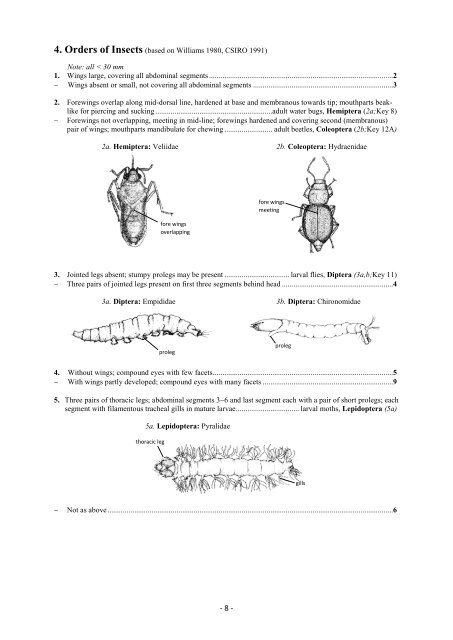Guide riffle invertebrates Australian Wet Tropics streams
1709Guidetotheriffleinvertebrates
1709Guidetotheriffleinvertebrates
You also want an ePaper? Increase the reach of your titles
YUMPU automatically turns print PDFs into web optimized ePapers that Google loves.
4. Orders of Insects (based on Williams 1980, CSIRO 1991)<br />
Note: all < 30 mm<br />
1. Wings large, covering all abdominal segments ................................................................................................2<br />
− Wings absent or small, not covering all abdominal segments .........................................................................3<br />
2. Forewings overlap along mid-dorsal line, hardened at base and membranous towards tip; mouthparts beaklike<br />
for piercing and sucking .............................................................adult water bugs, Hemiptera (2a;Key 8)<br />
− Forewings not overlapping, meeting in mid-line; forewings hardened and covering second (membranous)<br />
pair of wings; mouthparts mandibulate for chewing ......................... adult beetles, Coleoptera (2b;Key 12A)<br />
2a. Hemiptera: Veliidae 2b. Coleoptera: Hydraenidae<br />
fore wings<br />
overlapping<br />
fore wings<br />
meeting<br />
3. Jointed legs absent; stumpy prolegs may be present .................................. larval flies, Diptera (3a,b;Key 11)<br />
− Three pairs of jointed legs present on first three segments behind head ..........................................................4<br />
3a. Diptera: Empididae 3b. Diptera: Chironomidae<br />
proleg<br />
proleg<br />
4. Without wings; compound eyes with few facets ..............................................................................................5<br />
− With wings partly developed; compound eyes with many facets ....................................................................9<br />
5. Three pairs of thoracic legs; abdominal segments 3−6 and last segment each with a pair of short prolegs; each<br />
segment with filamentous tracheal gills in mature larvae ................................. larval moths, Lepidoptera (5a)<br />
5a. Lepidoptera: Pyralidae<br />
thoracic leg<br />
gills<br />
− Not as above .....................................................................................................................................................6<br />
- 8 -


